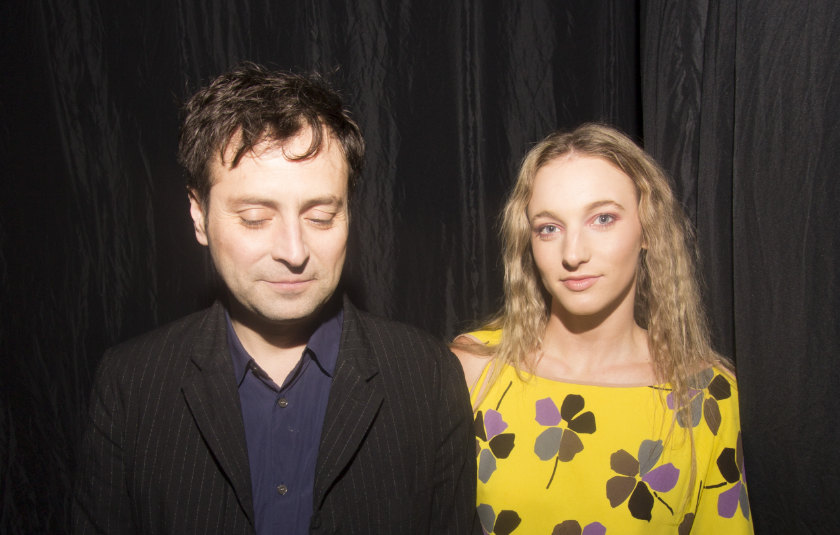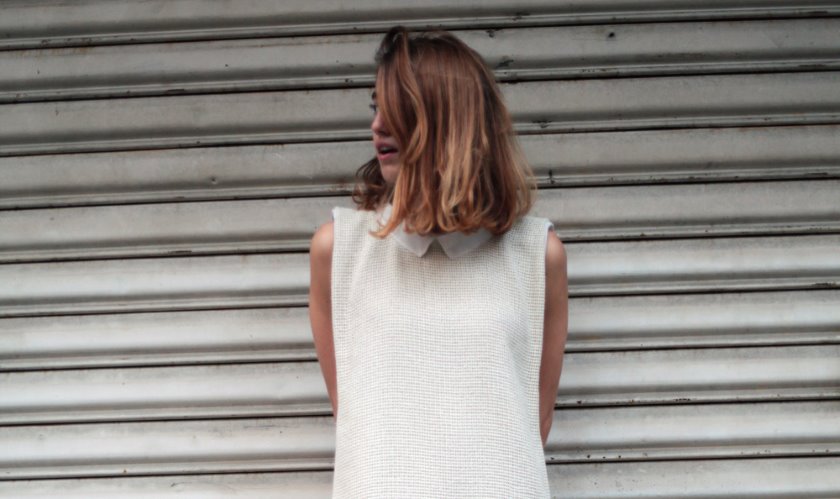
 FASHION Puglia-born, London-based Nico Didonna (right) started with a dream to travel, and found himself as one of the UK’s sought-after creators of quality, classic design with a contemporary touch. He tells Jack Yan his story
FASHION Puglia-born, London-based Nico Didonna (right) started with a dream to travel, and found himself as one of the UK’s sought-after creators of quality, classic design with a contemporary touch. He tells Jack Yan his story
Photographed by Morax Photography
Modelled by Sophia Nooshin



Jack Yan is founder and publisher of Lucire.
Avid watchers of London Fashion Week will be familiar with Nico Didonna, the Italian-born designer who began in menswear just before the new millennium, gaining such a reputation that he saw fit to branch out into womenswear in 2007, instantly going on to the official catwalk that year. Those who know his designs will talk of his inventiveness as well as his craft and quality, though the story, as always, is more complicated than a designer graduating from London College of Fashion and setting up a label.
Hailing from Puglia, one of Italy’s most culturally rich regions, Didonna set off from his homeland, describing himself as a ‘young, vivacious man’ with ‘a desire to travel’. It was no surprise, then, that he originally studied hotel management, and worked all over Italy at first, then other European countries.
‘When in Milan, I became friends with a group of American make-up artists,’ he recalls. The idea of travelling to the United States came up, and Didonna felt his future was there.
‘My spoken English at the time was very basic, so it was suggested to me that I come to London for a short period and to study,’ he tells Lucire.
London represented freedom to young Didonna: a multicultural hub, something that he has since described as remaining one of London’s draws, he fell in love with the city. However, that first trip was ‘transitional,’ and originally meant little more than a stopover as he headed to the us.
‘After nine months in London of pure studies and hard work to sustain myself, finally I went to America. Needless to say that I didn’t fall in love with it. First in Florida, then New York, and the Bahamas. At this point, I started missing Europe.’
His experience in the Americas lasted eight months. At that time, he worked in catering. ‘I came back to Europe, still battling in my mind where to go: Milan or London … London won the battle, so I packed all I had, bought a one-year open ticket, and on the 7th January, 1987, I landed in London.’
By this time Didonna was in his 20s, having already seen part of the world.
It got to a point where Didonna realized time was not standing still and he was still stuck about his next move. He sent in a basic portfolio to the London College of Fashion. ‘I was accepted straight away. This made me so happy—finally my dream was getting closer to realization.’
There had been an inkling of his career to come: ‘I always had it in me,’ he says. ‘As a teenager, I used to buy clothes that I could transform.
‘Coming from Puglia, this artisanal skill was not encouraged to me, so I kept dreaming. In my mind, I was styling, making garments and accessories.’
On his first day at the College, at age 29, he felt a new chapter in his life had dawned, and that he had found his calling. ‘The excitement was intense. No task was big enough. My hand was up all the time asking questions … I kept thinking, “This is it, you cannot fail now.”’
Things got tougher with the higher national diploma course. His finances were limited, and he faced a dilemma: should he go back to working part-time in catering to make a few pounds, or come up with another solution that would keep him in fashion?
‘I noticed that the clothes I was making for myself, and wearing them, received great compliments and a lot of attention, so I started a small T-shirt production [line] with the help of some students.’ This blossomed and turned into a full-time role by the time he graduated. Didonna never worked for another label: the T-shirt business was effectively his apprenticeship. ‘Students were wearing [our designs] out in clubs where they attracted the attention of some shop buyers. Big orders were coming in fast, and the help of fellow students was not sufficient any more.’ The small production line was not so small at this stage, with Didonna putting out T-shirts, vests and other items.
Something had to be done to take the business to the next level. ‘I approached factories that could meet the demand. By now I had developed trousers, shorts, tank tops, [and] shirts—a capsule collection for young men with joie de vivre.
‘I then was asked to be part of a pop-up multi-brand shop, sharing the space with other five designers in the heart of Soho, Berwick Street.’ Soon, as the other designers departed with the space not suiting them, Didonna became the only brand left. He acquired the others’ shares, and ‘one year later, I had all the shop in my name, where I stayed till June 2004.’ That year was regarded as the one where his menswear range really made a mark in the market-place.
After that, with the business continuing to grow, it moved to larger premises (1,300 ft²) in d’Arblay Street, still in Soho. It was that space that allowed Didonna to flex his creative muscles and branch out into womenswear. In 2007 he was part of London Fashion Week, showing his women’s ready-to-wear, and attracting a wider audience, as well as professional stylists who have worked with his clothes dressing various celebrities, taking his name further. In 2015, he moved to his current atelier at 29 Great Windmill Street.
A Nico Didonna design is recognizable: there is a classic foundation with a more inventive, sometimes even avant-garde, take. He describes his philosophy as ‘classic with a twist’, and that the avant-garde aspects form some of those twists. However, he says, ‘Plain, uncut is what I strive for.’
He has had to be clever. Using expensive cloth, he aims to waste as little as possible, and developed a technique that has matured over time. ‘As we cut the cloth as little as possible, and we use the cut-outs to create pieces of the creation, so nothing ends up in the trash.’
In addition, he believes his Italian upbringing has helped with his design approach, ‘plus the fact that my aunties are all seamstress. As a young guy, growing up with them has left a mark on me.’
His approach is also sustainable. Not only is there minimal waste from cutting the fabric, he aims to use sustainable fabrics. ‘If I create garments that have no waste, I’m on top.’
He adds, ‘Sustainability is the first element I look [for] when choosing the fabric. I always love the feel of natural yarns, and for that, I use them a lot.’ Fine fabrics, including Egyptian cotton, alpaca wool, silk and cashmere make their appearances, while manufacturing takes place locally.
continued below
 Beautifully tailored menswear is where Nico Didonna first made his name in London
Beautifully tailored menswear is where Nico Didonna first made his name in London
Those who choose a Nico Didonna design seek quality, luxury and exclusivity, and on that note he also offers a bespoke service.
His spring–summer 2021 collection is based on the idea of modern people on the go. ‘This crazy time has definitely contributed to the way we behave, and indirectly, the way we buy clothes,’ he notes. ‘This new collection is more relaxed than ever, so comfortable and versatile, adapting from the work time to relaxing and going out time, with the same ease.’ There is a voluminous, relaxed silhouette, and Didonna adds that it also has a strong emphasis on sustainability.
Fortunately, Britain’s various COVID-19 lockdowns have been useful to him. ‘The unprecedented situation, in many aspects, has been favourable to me. For the first time in years, I was able to dedicate time to cut and make garments under no pressure, and I’m pleased with the outcome.’ What is less clear is whether London is still such a multicultural hub with Brexit. As the country’s departure from the European Union happened during lockdown, Didonna says we still have to wait and see, but he would like to see it continue as a multicultural centre for creativity.
Didonna has also done numerous collaborations and private commissions, citing the film industry as the best ones to work with. ‘One particular episode springs to mind, and that was [when I was] asked to design some costumes for Harry Potter and the Deathly Hallows. Having signed a confidentiality agreement, I was not allowed to talk about it until after the movie was launched.
‘At one point all the crew was filming in Piccadilly Circus, and everyone was talking about it. One of my jackets made the front page of a tabloid the following day. It was so hard for me not to be able to say I made that!’
He has also collaborated with the stage production of Mamma Mia!, the Eurovision movie, and Alien: Covenant.
It’s at a point where Didonna finds himself in the enviable position of having film and theatre productions approaching him. ‘I would like to think that it is the diversity of my product that lends to these kinds of productions, plus the fact that having the atelier, it becomes much easier to collaborate for any sets.’ He’s always interested in future collaborations: ‘It’s challenging but I love it.’
Celebrities are also drawn to him: actresses Denise van Outen, Danielle Brown and Gemma Merna, musicians Will.i.am, Peter André and So Solid Crew, American lawyer Nancy dell’Olio, footballer Tom Williams, reality stars Amy Childs, Harry Derbridge and Nicola McLean, and presenters Jeremy Vine and Rikaya Tagoe are among his supporters, whom Didonna says hear about him through word of mouth, or through stylists who have attended his shows or presentations. He says, ‘The uniqueness of the creations lends itself’ to a celebrity audience.
Didonna says he is looking forward to travelling again, once it is permitted. He says he would like to look at ‘a trip abroad, a proper holiday—a well deserved one, it has been almost two years.’ It will undoubtedly give new inspirations and insights as Didonna continues his ‘classic with a twist’ philosophy. •

Related articles hand-picked by our editors

Demystifying Stephen Jones
In another look back at our 20 years, Stephen Jones, OBE, one of the great names in millinery, talked to Jack Yan in 2013 about his creative process, his drive, and his favourite collection
Photographed by Yvonne Shearer
Catwalk photographed by Matthew Beveridge
From issue 30 of Lucire

One to one with Paulo Melim Andersson
Chris Park catches up with the Swedish-born designer whose work has graced the lines of Marni, Chloé, and Zadig & Voltaire
Catwalk photographed by the author

Timi Hayek: sheer charm, relaxed sportswear
Tamara Madison talks to Beirut-based designer and Central Saint Martins alumna Timi Hayek, delivering an understated, minimalist æsthetic with her latest collections
Advertisement
Copyright ©1997–2022 by JY&A Media, part of Jack Yan & Associates. All rights reserved. JY&A terms and conditions and privacy policy apply to viewing this site. All prices in US dollars except where indicated. Contact us here.